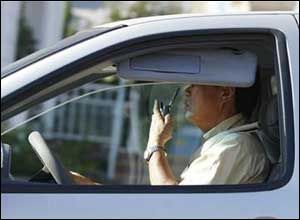 AP File Photo |
I pulled into the local cleaners to drop off some laundry. The petite teenage girl working behind the counter was engaged in an animated conversation on her cell phone. She continued the conversation while sorting my laundry and running the credit card. She was describing, in great detail, how to convert music files from Napster to a format that could be transferred to an iPod. She never really said anything to me. Finally, she pushed the credit card receipt to me to sign and continued to describe how to plug in the iPod to a computer. I signed it, she said nothing to me, and I left. As I got into my car I saw she was doing the same to another customer.
Not long ago I flew to Albuquerque to speak at a paramedic graduation. After I got off the plane, I caught the shuttle to the rental car center. As we were approaching the destination, the bus driver warned us that it was illegal to talk on a cell phone while driving in Albuquerque. Just as he said that, I looked out the window and saw a police officer driving in his patrol car while talking on his cell phone.
Recently, I have had to drive twice to Oklahoma. Invariably, I encountered something in traffic that was disrupting the entire flow. Sometimes it was a car going 40 miles per hour in the left lane. Sometimes, it was a truck weaving back and forth between lanes. The thread that I have found in common in both of these is that the drivers were talking on a cell phone.
I came across something even more shocking last year while I was driving from Notre Dame University to O’Hare Airport in Chicago. As usual, every highway in Chicago was under construction and traffic was down to one lane. In front of me was a brand-new Chevrolet crew cab pick-up with dual rear wheels and a camper shell, that was going 40 miles per hour and weaving back and forth between the temporary lane barriers. I followed this person for at least 20 miles and started to fear that he would make me late for my plane.
I was getting pissed-off to a degree heretofore unseen. I contemplated calling the Chicago Police because surely this fellow was drunk; I could think of no other explanation for such horrible and inconsiderate driving. When a second lane opened up, and I passed the 20-foot long moving traffic jam, I gave the usual dirty look to the driver. This idiot was not only talking on a cell phone, he had a laptop computer installed on a pedestal just to the right of the steering wheel. He was typing while talking and driving. What an ass.
In contrast, several years ago I was riding with the Queensland Ambulance Service (QAS) out of Surfer’s Paradise, Queensland, Australia. The driver of the ambulance needed to use his cell phone, so he pulled over and made the call. It seems that the cops in Queensland will readily write an ambulance officer a ticket for such behavior. Also, the QAS has fairly stiff sanctions for driving while talking on a cell phone.
Cell phone operation, especially text messaging while driving, is an increasing public safety hazard. This is especially true with inexperienced teenage drivers who now communicate almost exclusively through text messages. The medical and engineering literature is increasingly full of data that shows that cell phone usage while driving is a risky behavior. A French study found that the greatest risks for a serious motor vehicle collision were: exceeding the speed limits on rural roads, risky use of a cell phone, and driving while sleepy1. An Australian study showed that men, younger drivers, and metropolitan residents were the most likely to use a cell phone while driving2. While there is some evidence that the use of hands-free cell phones is less dangerous, it still poses as driving distraction and risk3. There is some evidence that laws banning cell phone usage help, but do not totally eliminate this risky behavior4.
EMS is starting to embrace injury and illness prevention programs (e.g., child car seats, bicycle safety helmets, drunk driving). We need to embark upon a campaign to reduce the growing carnage from cell phone distractions while driving—especially among teenagers. This is especially true for text messaging while driving. These behaviors are as risky as drunk driving. All EMS operations should have a strict and clear policy that forbids cell phone usage by EMS drivers while the ambulance is in motion. I would argue that cell phone usage is so distracting that it should be forbidden by all crew members during emergency operations.
I am not against cell phones. I love and hate mine. It allows me to stay in touch with the people through voice and emails. But, it should not be used while driving. I have to admit that I have checked emails and talked on the cell phone while driving. But after almost hitting a parked van on Texas Highway 75 last week, I have resolved to change my behavior. You should too. And, we need to start encouraging the populations we serve to do so as well.
References
1Nabi H, Rachid Salmi L, Lafont S, et al. Attitudes associated with behavioral predictors of serious road traffic crashes: results from the GAZEL cohort. Inj Prev. 2007;13:26-31.
2McEvoy SP, Stevenson MR, Woodward M. Phone use and crashes while driving: A representative survey of two Australian states. Med J Aust. 2006;185:628-629.
3McCartt AT, Hellinga LA, Bratiman KA. Cell phones and driving: a review of the research. Traffic Inj Prev. 2006;7:89-106.
4McCartt AT, Geary LL. Longer term effects of New York State’s law on drivers’ hand held cell phone use. Inj Prev. 1004;10:11-15.


